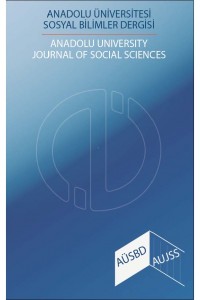Öz
Endogenous money view can be described as the supply of money is not under the absolute control of the central banks and emerges endogenously within financial markets, market structure and credit availability. Most importantly, the theory of endogenous money reveals enormous significance of the source of interest rates in the definition of financial fragility. The aim of this article is to present the post-Keynesian theme of the monetary circuit as argued by the General Theory of Transformational Growth. According to this approach, capital adequacy requirements are procyclical, and for this reason, it is important to analyze the relationship between the growth rate and the rate of interest, since the growth of bank capital is tied to the latter.
Anahtar Kelimeler
Kaynakça
- Kaldor, N. (1981). Origins of the New Monetarism. University of Cardiff Press, Cardiff.
- Lavoie, M. (1986). Systematic Financial Fragility. Journal of Post Keynesian Economics, 9(2).
- Lavoie, M. (1992). Foundations of Post-Keynesian Economic Analysis. Edward Elgar, England. Marx, K., Capital, Volume III
- Minsky, H. (1957). Central Bank and Money Market Changes. Quarterly Journal of Economics, LXXI(2).
- Minsky, H. (1975). John Maynard Keynes. New York: Columbia University Press
- Minsky, H. (1977). A Theory of Systematic Fragility. In Altman and Sametz (eds) Financial Crises, John Wiley and Sons.
- Minsky, H. (1982). The Financial Instability Hypothesis: an interpretation of Keynes and an Alternative to Standard Theory. In Inflation, Recession and Economic Policy, Wheatsheaf Books Ltd., Great Britain.
- Minsky, H. (1982). The financial-instability hypothesis: Capitalist process and the behavior of the economy. In Kindleberger, C. P. and J.-P. Lafargue (eds.) Financial Crises, 13-39. New York: Cambridge University Press.
- Minsky, H. (1996). The Essencial Caracteristics of Post Keynesian Economics. In G. Deleplace and E. Nell (ed.), Money in Motion, Macmillan Press, London.
- Mollo, M. L. R. (1999). The endogeneity of money: Post-Keynesian and Marxian concepts compared. http://www.countdownnet.info/archivio/teoria/168.pdf
- Moore, B. (1988a). The Endogenous Money Supply. Journal of Post Keynesian Economics, X(3).
- Moore, B. J. (1988b). Horizontalists and Verticalists: The Macroeconomics of Credit Money. Cambridge, Cambridge University Press.
- Moore, B. (1991). Money Supply Endogeneity: ‘reserve price setting’ or ‘reserve quantity setting? In Journal of Post Keynesian Economics, 13(3)
- Nell E.J. (1990). The quantity theory and the mark-up equation. Economie Appliquée, XLIII(2), 33-42.
- Nell, E. J. (1998). The General Theory of Transformational Growth. Cambridge: Cambridge University Press.
- Nell, E. J. (2000). Transformational Growth and Financial Instability: The rate of Interest and The Rate of Growth. VII Jornadas De Economia Critica, Albecete 3-5, Febrero
- Nell E.J. (2004). Monetising the Classical Equations: a theory of circulation. Cambridge Journal of Economics, 28, 173-203.
- Nell, E. J.(2007). Aggregate Demand, Employment and Eqilibrium with Marginal Productivity. In Pressman, S., Forstater, M. (Ed.), Mongiovi, G. (Ed.). (2007). Post-Keynesian Macroeconomics. London: Routledge.
- Nell, E. J. (2008). Transformational Growth: From a Marshallian (almost Neo-Classical) System to Keynesian Growth. (draft version/unpublished).
- Palley, T. (1997). Endogenous Money and the Business Cycle. Journal of Economics, 65(2), 133-149. Retrieved from http://www.jstor.org/stable/41794569
- Palley, T. (2001). Endogenous Money: What it is and Why it Matters. http://www.thomaspalley.com/docs/articles/macro_theory/endogenous_money.pdf
- Rochon, L. P. (1999). Credit, money, and production: an alternative post-Keynesian approach. Edward Elgar publishing.
- Rochon, L. P., Vernengo, M. (2004). Interest Rates, Effective Demand, and Financial Fragility: Edward Nell and The Trieste Tradition. In Growth, Distribution and Effective Demand: Alternatives to Economic Orthodoxy (Essays in honor of Edward J. Nell, edited by G. Argyrous, M. Forstater, and G. Mongiovi, M. E, Sharpe Inc.
- Wray, R. (2007). Endogenous Money: Structuralist and Horizontalist. Working Paper No. 512, The Levy Economics Institute and University of Missouri–Kansas City.
Ayrıntılar
| Birincil Dil | İngilizce |
|---|---|
| Bölüm | Makaleler |
| Yazarlar | |
| Yayımlanma Tarihi | 21 Mart 2019 |
| Gönderilme Tarihi | 9 Nisan 2018 |
| Yayımlandığı Sayı | Yıl 2019 Cilt: 19 Sayı: 1 |
Bu eser Creative Commons Atıf-GayriTicari 4.0 Uluslararası Lisansı ile lisanslanmıştır.


